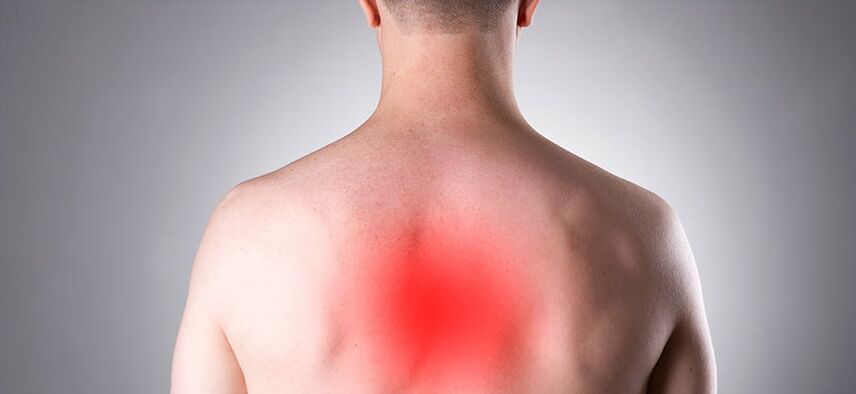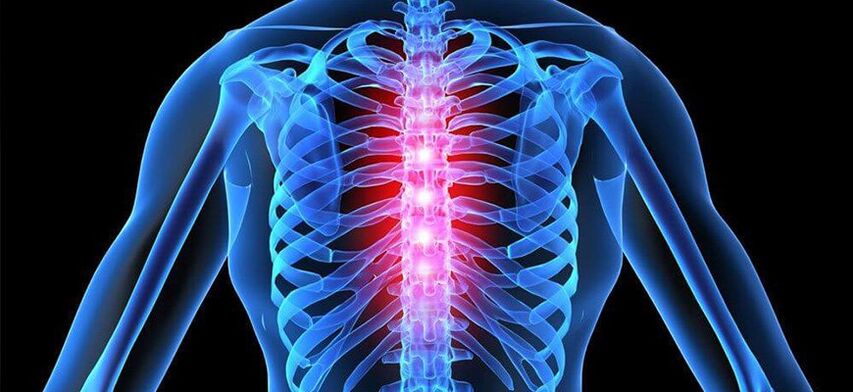Osteochondrosis of the chest is a quite dangerous disease, because the diagnosis process is difficult, so the disease can often only be identified in the late stages. Initially, cervical spondylosis was considered a disease of the elderly, but recently this disease has a significant "rejuvenation" trend, so it is important to know the main symptoms and treatments to improve it. improve clinical condition. image of the disease. The difficulty in diagnosis is due to the fact that the vertebrae located in the thoracic region are least affected by stress and trauma. However, limited mobility does not guarantee safety, so the occurrence of diseases in this part is also very common. Statistics show that this disease is not directly related to the aging process and gender.
Characteristics of the disease
This disease is characterized by pathological processes that lead to negative changes in the structure of tissues. As a result of this, destruction of the annulus fibrosus of the intervertebral disc may occur and the nucleus pulposus may protrude as a result. This condition is very dangerous because there is a risk of compressing the spinal cord and causing further disability for the patient. The progression of the disease in childhood can lead to premature aging of the musculoskeletal system even before its final formation. That is why timely diagnosis of the pathology at the early stages, when destruction of the vertebrae and neighboring tissues has not yet occurred, is extremely important.
Clinical symptoms
This disease manifests itself in completely different ways, depending on the stage. Therefore, we will highlight the general symptoms of osteoarthritis of the chest area:
- Pain. It can occur not only when performing any action, but also when remaining in a static position for a long time.
- Stiff movements, preventing free rotation of the body.
- Difficulty breathing due to feeling of strong pressure in the middle of the back.
- Problems with the functioning of the digestive tract and other internal organs.
Very often the disease is manifested by pain in the left chest, which can be understood as a symptom of heart disease. This complicates the diagnosis, but the specialist will make a comprehensive assessment of all the patient's complaints, which will allow the correct interpretation of all existing symptoms. Knowing the symptoms of thoracic osteoarthritis, you can quickly seek professional help. We recommend that you pay more attention to the signals your body gives.

When diagnosing, it is important to know how thoracic osteoarthritis manifests, because this disease progresses silently, so it is easy to confuse it with other diseases. Based on the nature of the pain, we can distinguish the main types of osteoarthritis. One condition is characterized by persistent pain in the damaged spinal area, and the second is characterized by the appearance of acute attacks that interfere with a person's movements, complicating respiratory functionhis.
Cause of the disease
The following causes of osteochondrosis can be identified:
- Pathological processes negatively affect the structure of the intervertebral disc. In particular, there is a certain genetic predisposition to this disease.
- Inactivity related to carrying out one's work functions and leisure activities.
- Scoliosis, which causes increased stress on certain areas of the spine.
- Mechanical damage to the chest.
- Strength training involves lifting large loads.
- Frequent stressful situations.
- Hypothermia of the body.
- Calcium deficiency.
- Hormonal disorder.
Disease classification
Spondylosis develops in stages, each stage is characterized by its own negative manifestations:
- First level.The initial stage is characterized by the loss of moisture that occurs in the intervertebral disc. Elasticity decreases, low-intensity pain appears and disappears completely when the patient takes a comfortable position.
- Second level.The loss of moisture in the disc continues. As a result, it becomes smaller and cracks appear, some of which are quite deep. The muscular corset tries to adapt, trying to maintain the stability of the spine, leading to spasms and quite severe pain in the back, chest and limbs.
- Third degree.At this stage, the breakthrough of the nucleus pulposus to the outside is observed. At its core, it is a hernia between the vertebrae, the pain of which lasts throughout the day. A person is forced to change his type of activity to one where the discomfort will not be so intense.
- Fourth degree.Prolonged osteochondrosis of the thoracic spine is dangerous because severe restructuring of all tissues begins to occur at the site of damage. There is a natural replacement of annulus fibrosus tissue by bone, resulting in severe stiffness of movement. The appearance of bone spurs and spinal deformities are also observed.
Severe stage

Manifestations of thoracic cartilage degeneration in the acute stage are characterized by the appearance of paroxysmal pain, which is extremely difficult to alleviate with available means. Self-medication at this stage is unacceptable, so you should immediately consult a doctor or call emergency help for pain relief. Only a neurologist can correctly interpret your complaints and prescribe appropriate further examination and treatment. During an exacerbation, it is extremely important to alleviate the patient's condition. Exacerbation of the disease can be caused by a variety of factors, including stressful situations, hypothermia, and activities that involve intense stress. In this condition, the patient's health is significantly impaired, breathing may become difficult, and mobility may be limited. In some cases, hospitalization may be required.
Basic diagnostic methods
Signs of cartilage degeneration in the chest area include pain in different locations, stiff movements and difficulty breathing. The difficulty in diagnosis lies in the fact that a large number of diseases of different nature fit this description. In particular, there is such a concept - "gastric syndrome", which is characterized by the appearance of pain in the epigastric region, which can be misinterpreted as a manifestation of gastritis or other diseases of the gastrointestinal tract. Digest. Only modern diagnostic methods can make an accurate diagnosis, on the basis of which the neurologist will prescribe appropriate therapy. It all starts with a detailed interview with the patient, identifying existing complaints and comorbidities. After collecting the history, the doctor conducts a direct examination using special tests. After that, the patient must undergo the necessary laboratory tests, as well as X-rays and MRI scans. Magnetic resonance imaging allows you to study the condition of the spine in more detail, determine existing pathologies, size and location of hernias (if any).
How does the treatment process work?
It is extremely important to know what to do about osteoarthritis in the chest area. After confirming the diagnosis, the doctor prescribes an individual treatment regimen for the patient. It is necessary to take into account age and the presence of comorbidities, as well as allergies to certain medications. In the early stages, treatment is carried out with various drugs: nonsteroidal anti-inflammatory drugs, analgesics and antispasmodics. The main goal at this stage is to soothe the patient's condition, relieve pain and spasms of muscle tissue. In especially severe cases, when immediate acute pain relief is required, anesthetics are used. Topical agents in the form of ointments and gels can also be used, but their effectiveness is slightly lower due to the difficulty of delivering the active substance to the lesion. In general, the treatment of osteoarthritis of the thoracic spine is an integrated approach that combines the use of several techniques. Only such therapy may not provide a one-time positive result but may improve the clinical situation over time.
Physical therapy
Therapeutic exercises are performed after pain relief. It is extremely important to perform all movements slowly, avoiding sudden movements to prevent the condition from getting worse. Remember that if exercise causes you pain, you should stop immediately and consult your doctor.
Massage therapy

Muscle spasms, increased tone, pain - this is how the disease manifests itself. To eliminate these symptoms, massage can be used, which must be performed by a qualified specialist. These procedures can be used not only for therapeutic purposes but also as a good preventive measure.
Prevent
The consequences of thoracic osteoarthritis will not be too serious if you strictly follow certain medical recommendations. If a specialist has prescribed you bed rest, then in no case should you ignore this, otherwise your condition may worsen. A person must limit physical activity, so he will have to refuse to go to the gym or do weight training. An important component of primary prevention is the timely identification of individuals with early signs of thoracic spine osteoarthritis during the medical examination. Another no less important point is proper nutrition, which includes avoiding certain foods. It is necessary to limit salt consumption, so smoked meats, spicy spices and pickles will have to be eliminated from the diet.
It is very important to use chondroprotective drugs to slow down the process of cartilage degeneration in the thoracic spine, nourish and improve metabolic processes in cartilage tissue.
Osteoarthritis of the thoracic spine can be treated. To do this, you must strictly follow the doctor's recommendations, as well as adhere to the established treatment regimen. Primary osteoarthritis in the thoracic spine is the best treatment, so it is extremely important to pay more attention to your body, responding to the slightest symptoms of the disease. . To avoid the possibility of recurrence, you need to follow preventive measures and monitor your posture, which is especially important when working sedentarily. Contact only qualified doctors, because only they can prescribe a suitable treatment regimen and further recovery.

























